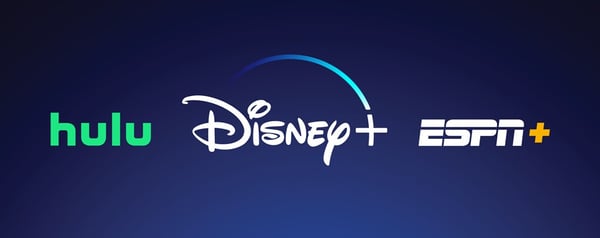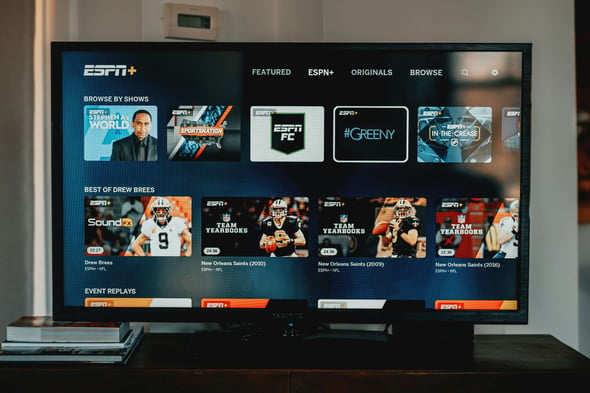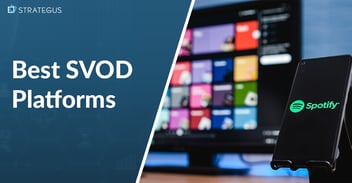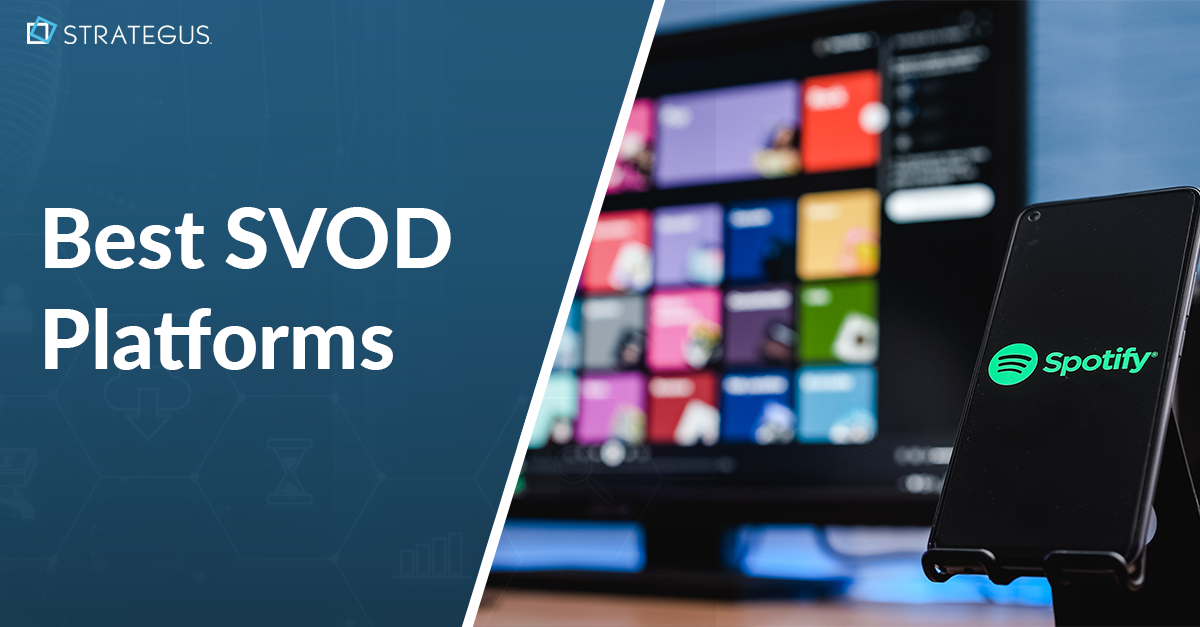- Home
- Strategus Blog
- 10 OTT Trends Shaping CTV Advertising in 2024
10 OTT Trends Shaping CTV Advertising in 2024
 Traci Ruether
Traci Ruether
15 minutes read

In the 17 years since Netflix launched its streaming service, over-the-top (OTT) media has become standard. What started as a novel concept now defines how we consume entertainment. That’s why the average U.S. household now subscribes to four streaming services and almost 90% of homes have an internet-connected TV.
OTT media also looks a lot different today than it did in 2007. Platforms like Netflix were initially launched as a way to supplement cable packages by providing access to a library of exclusive shows and movies. Subscription video on demand (SVOD) was the norm, boasting premium content that could be watched without ads.
Today, the OTT model has grown into a more versatile ecosystem that caters to every viewing preference and price point. Many services like YouTube TV and Tubi blur the lines between traditional TV and streaming, offering linear channels alongside on-demand libraries. What’s more, ad-supported OTT has become standard, with some providers streaming content to viewers at no cost at all.
In this guide to OTT trends, we explore what the future of streaming TV looks like and how advertisers can get ahead. Keep reading or navigate to the section of your choosing to learn more.
1. Ad-Supported Streaming Becomes the Norm

According to Delloite, almost half (47%) of U.S. consumers report being frustrated by the growing number of subscriptions required to watch streaming content. This has driven many viewers to cancel OTT services in recent years, equating to stagnating growth and increased churn.
But what if there was a more cost-effective way to stream content online? Enter ad-supported streaming.
Every major streaming platform — including Netflix, Disney Plus, and Max — now offers an ad-supported tier. For some (cough Amazon Prime), this has become the default option, signaling that connected TV (CTV) advertising will only grow.
And while OTT has surpassed traditional cable and satellite in terms of eyeballs, it lags in terms of advertiser adoption.
Roku’s Q4 shareholder letter captures this nicely:
"There remains a significant gap between viewership and ad dollars on TV streaming. In 2023, U.S. adults aged 18-49 spent more than 60% of their TV time on streaming, while advertisers spent just 29% of their TV budgets on streaming."
In other words, marketers who are quick to adapt to this reality will have the opportunity to engage audiences that are currently underserved.
2. Expanding Flexibility in How Viewers Stream

Streaming claims the largest piece of the TV viewing pie and is expected to eclipse pay TV in revenue this year. It should come as no surprise that OTT providers achieved this by copying the playbook of traditional TV.
We now use OTT for everything from catching up on the news to cheering on our favorite teams. This breadth and depth of content that streaming services offer today brought with it additional distribution models.
Eyevinn Technology’s Magnus Svensson explains:
“As the industry matures, streaming services are increasingly adopting strategies that resemble the blueprint of traditional TV. But as time goes by, streaming is starting to look a lot like the TV we've always known. This isn't about stepping back; it's about recognizing what has worked for TV for so long.
Traditional TV has been around for ages because it knows how to keep viewers happy and make money at the same time. It brings us shows and ads at certain times, charges subscription fees, and sometimes sells popular shows to other channels. This mix keeps things running and makes sure there's always something new to watch. Plus, watching TV together has been a big part of our culture, giving us shows and moments that everyone talks about.”
Today, ad-supported OTT streaming spans several categories:
- Hybrid video on demand (HVOD): Ad-supported subscriptions to services like Netflix, Prime, and Disney+ fall into the HVOD category because they generate revenue through a mix of commercials and subscription plans. This appeals to viewers who want premium content but can’t justify the high-end price tag.
- Virtual multichannel video programming distributors (VMVPD): YouTube TV is perhaps the best example of a vMVPD. These services deliver linear TV channels (with ads) to paying subscribers. Households looking to cut the cord without losing access to premium live sports content and must-watch shows from popular cable networks are the target market for these services.
- Free ad-supported streaming TV (FAST): For viewers looking to do away with paid subscriptions altogether, FAST apps make it easy. These streaming services deliver linear channels at no cost to viewers — playing everything from reruns, old movies, platform-specific content, and local news. Many smart TVs (like Roku) have default FAST apps (like the Roku Channel) within the interface, giving viewers a free and easy option for lean-back viewing out of the box.
3. New Approaches to TV Bundles

Another way that OTT providers are looking to meet customer demands and reconfigure their profit model is through bundled pricing.
The Disney Bundle, for example, gives users access to Hulu, Disney+, and ESPN+ for $14.99 a month — which saves 44% versus buying each service individually. This approach also reduces churn because consumers are less likely to give up access to all three of these services and once than they would be to nix a single platform.
Telecom providers are getting in on this strategy too, with Verizon releasing a bundle with Netflix and Max to its wireless customers. But that’s not all. ESPN, FOX, and Warner Bros have just announced their plans to launch a direct-to-consumer skinny bundle focused on live sports content.
Which brings me to the next point.
4. OTT Takes Over Live Sports

For the longest time, live sporting events were the saving grace of cable and satellite. OTT adoption lagged for several reasons:
- The technical difficulties of streaming live broadcasts needed to be worked out. Reducing lag while maintaining reliability was an absolute must before investing in live sports.
- Licensing rights had to switch hands from the legacy media companies that had monopolized sports broadcasting for so long. Because these contracts span many years, the transition took time.
- Figuring out a revenue and distribution model that made sense for this type of content was the last piece of the puzzle. As we now know, the combination of ad-supported and subscription-based monetization ensures the highest profit while maintaining demand, which is why HVODs, vMVPDs, and skinny bundles have embraced it.
Today, sports account for 30% of all connected TV streaming, and that number will grow substantially in 2024. AppleTV+, Amazon Prime, YouTube TV, and even Netflix have made live sports streaming a part of their long-term strategy.
This trend isn’t just displacing legacy media companies, it’s shaking up the entire sports media ecosystem. Ongoing obstacles surrounding content distribution and ownership will be a trend throughout 2024.
ESPN, Fox, and Warner Bros announced a joint streaming app last month, prompting Fubo to file an antitrust lawsuit against the media giants. We expect live sports streaming to turn into an all-out war this year (and that’s putting it lightly).
5. Retail Media Eyes CTV
When Amazon made Prime Video ad-supported by default in January, the retailer quietly transformed itself into the single largest player in CTV advertising. The graph below shows Amazon’s dominance in terms of audience size, but there’s more to it than that.
Think about it. Amazon now owns every step of its CTV ecosystem, boasting:
- The best retail media network
- Owned and operated ad-supported inventory
- A proprietary suite of CTV devices (Amazon Fire TVs)
- The vastest collection of shopper data for targeting and measurement
- In-house demand-side platform (DSP) to monetize inventory
- The world’s largest e-commerce marketplace
The tech giant also has cloud computing properties to build out its ad stack and has been snatching up media rights to live sporting events like Thursday Night Football. This vertical and horizontal integration makes Amazon the most compelling flywheel that the world has ever seen.
Walmart is also eyeing CTV as a way to compete. But as always, the big box store is about three years late to the party.
Walmart announced its acquisition of Vizio in February as a way to push deeper into the world of advertising. This will enable the retailer to sell TV spots on streaming services and link advertisements to customers’ purchases.
Other retailers may also follow suit. Many view Roku as an acquisition target this year, which could be a strategic purpose for Kroger. The two organizations have already partnered up to combine retail media with streaming video. And with Roku’s stock tanking after announcing Q4 earnings, it just got that much cheaper from an acquisition standpoint.
6. Growing Fragmentation Across Walled Gardens
While Amazon’s vertical integration is great in theory, it introduces fragmentation. By creating a closed-loop environment that centralizes data and ad space, Amazon forces marketers to use its tech stack to run campaigns.
This walled garden approach has become standard across OTT providers. Google (YouTube TV) and Apple (Apple TV+) also control the data and ad inventory within their ecosystem.
Walled gardens are problematic for a couple of reasons:
- They limit transparency for marketers. Because walled gardens tie marketers to a single programmatic platform, they limit insight across the CTV ecosystem. Even when marketers opt to combine multiple inventory sources, the lack of cross-platform visibility makes it challenging to design holistic campaigns and cap ad frequency.
- They don’t allow for an audience-centric approach. Purchasing ads from individual publishers puts the focus on the content where ads run rather than the viewers themselves. This means that when the audience unsubscribes from a given service, marketers miss opportunities to continue messaging to these viewers.
This is why it’s more important than ever for marketers to find vendor-agnostic solutions that can integrate data and inventory across the CTV ecosystem. At Strategus, we’re committed to overcoming this fragmentation by providing access to a breadth of inventory and data partners.
7. Shoppable Ad Units and Interactive TV

Shoppable ad units are another innovation coming to CTV.
Imagine this: you're watching your favorite show on Hulu and a sleek new pair of sneakers catches your eye during a commercial break. Using your remote control, you’re able to click on the product and make a purchase, all within the streaming app.
While shoppable TV is still in its early stages, major players like Amazon and Disney are already experimenting. And given what we’ve already detailed about Amazon’s dominance in the world of CTV advertising and e-commerce, we expect that they’ll make some waves in 2024.
But shoppable ads are just one piece of the interactive TV puzzle. As technology evolves, we’ll also see more immersive and engaging OTT experiences through polling during live broadcasts, in-game betting during sporting events, or even interacting with virtual characters within commercials. The possibilities are endless, and many applications haven’t even been imagined yet.
8. Political Ads Dominate Commercial Breaks

U.S. politicians and the marketing agencies that serve them will be investing heavily in CTV advertising throughout 2024. As a result, viewers can expect an influx of political campaigns when viewing ad-supported OTT content.
While political TV advertising is nothing new (Eisenhower pioneered this tactic back in 1952), the hypertargeting capabilities of CTV bring us into a new era.
Media consultant Brad Adgate explains:
“As political ad dollars on linear TV stagnate, connected TV is forecast to garner more political ad dollars than in previous elections. As with other product categories, CTV provides political operatives with a greater amount of data than linear TV. With this superior information, a political operative can target persuadable voters based on demographics, behaviors, and on a specific campaign issue. In addition, ads can be geo-targeted reaching voters in specific voting districts and zip codes, as well as by income, and party affiliation among other variables.”
Another aspect of this to keep an eye on is the ad tech firms choosing to stay outside of this paradigm altogether.
In light of how user data has been weaponized in recent years to manipulate users, Microsoft has announced that it will ban political ads on its advanced TV platform Xandr, stating that advertising "for election-related content including election canvassing and election polls, political parties, candidates, and ballot measures is not allowed."
9. Improvements to User Experience
We’ve established that the future of OTT will lean more heavily on commercials. And yet, there’s a ways to go in terms of perfecting the viewer experience in ad-supported OTT environments.
Currently, it’s not uncommon for viewers to get served the same ad on repeat, as well as irrelevant ads altogether. Strategus Co-Founder and EVP of Strategy, Joel Cox, explains:
“The emphasis needs to be on improving user experience and measurability. Us marketers need to be thoughtful about the frequency of ads that households receive. And then, most importantly for everybody, we need to ensure that there's meaningful measurement associated with that, such that as soon as Mike buys the running shoes, the data can pass back their identity resolution to say, ‘We don't need to serve Mike in his household running shoe ads anymore.’”
Improved interoperability across the ecosystem and data portability will be key to these improvements, which is also a place where AI shows potential.
10. AI for Dynamic Ad Personalization
We couldn’t wrap up a 2024 trends list without mentioning AI.
While content recommendations and targeted ads have been AI-powered for 10+ years, additional forms of innovation are on the horizon. The existing machine learning technologies will soon be combined with generative AI’s content creation capabilities to take personalization to the next level.
Advertisers currently create multiple versions of their ad creative to target different buyers. For instance, a car dealership may create a commercial promoting the safety of a new minivan to target mothers of young children, while also creating ads for affordable sedans to target low-income individuals.

Soon, AI content creation will automate this process, enabling advertisers to spin up new ads on the fly. Mothers of young children won’t just see a minivan commercial, they’ll see one that’s the exact color they’ve been looking for, driving through a neighborhood that looks like their own. This hyper-personalization and localization of ads will ensure more relevant ad experiences, and make ad-supported OTT more bearable for viewers.
To fully achieve this, AI will also need to streamline data collection by incorporating info across multiple sources.
Conclusion
The OTT landscape is ever-evolving, which is why marketers must adapt their strategy on an ongoing basis.
At Strategus, we constantly bring new advertising capabilities to the market to account for the industry’s challenges and opportunities. That’s not all, though. We stay up to date on all the trends outlined above, working directly with brands and agencies to deliver holistic CTV campaigns that drive business results.
Our CTV advertising solutions combine the tech, expertise, and dedicated resources required to overcome the industry’s fragmentation and make the most out of your investment.
Contact us today to find out how we can help.

Traci Ruether is a content marketing consultant specializing in video tech. With over a decade of experience leading content strategy, she takes a metrics-driven approach to storytelling that drives traffic to her clients' websites. Follow her on LinkedIn or learn more at traciruether.com.
Strategus is a managed services connected TV(CTV) advertising agency with over 60,000+ campaigns delivered. Find out how our experts can extend your team and drive the result that matter most.
Talk to an Expert
OTT Advertising Trends to Watch
- Ad-Supported Streaming Becomes the Norm
- Expanding Flexibility in How Viewers Stream
- New Approaches to TV Bundles
- OTT Takes Over Live Sports
- Retail Media Networks Eye
- Growing Fragmentation Across Walled Gardens
- Shoppable Ad Units and Interactive TV
- Political Ads Dominate Commercial Breaks
- Improvements to User Experience
- AI for Dynamic Ad Personalization
Seeking a Custom CTV Strategy That Delivers?
What to read next

Best SVOD Platforms for Advertisers
The streaming wars have a new battlefront, and this time, it's all about your ad budget. Just a few years ago, SVOD meant "no commercials." Now, it...
12 minutes read

Third-Party Data Targeting for CTV: Benefits & Tactics
Third-party data. It’s a term that’s thrown around, and yet few take the time to detail its pros and cons — much less strategies for using...
7 minutes read

First-Party Data Targeting: Benefits and Tactics for CTV Advertising
First-party data is the information that companies collect directly from their customers rather than through intermediaries. Advertisers use this...
10 minutes read

Foot-Traffic Attribution: Tying Ad Impressions to In-Store Visits
The marketing funnel has changed. Today’s shoppers often begin researching products from the comfort of their homes and don’t set foot into a store...
8 minutes read


















